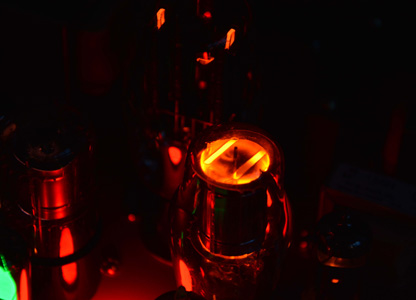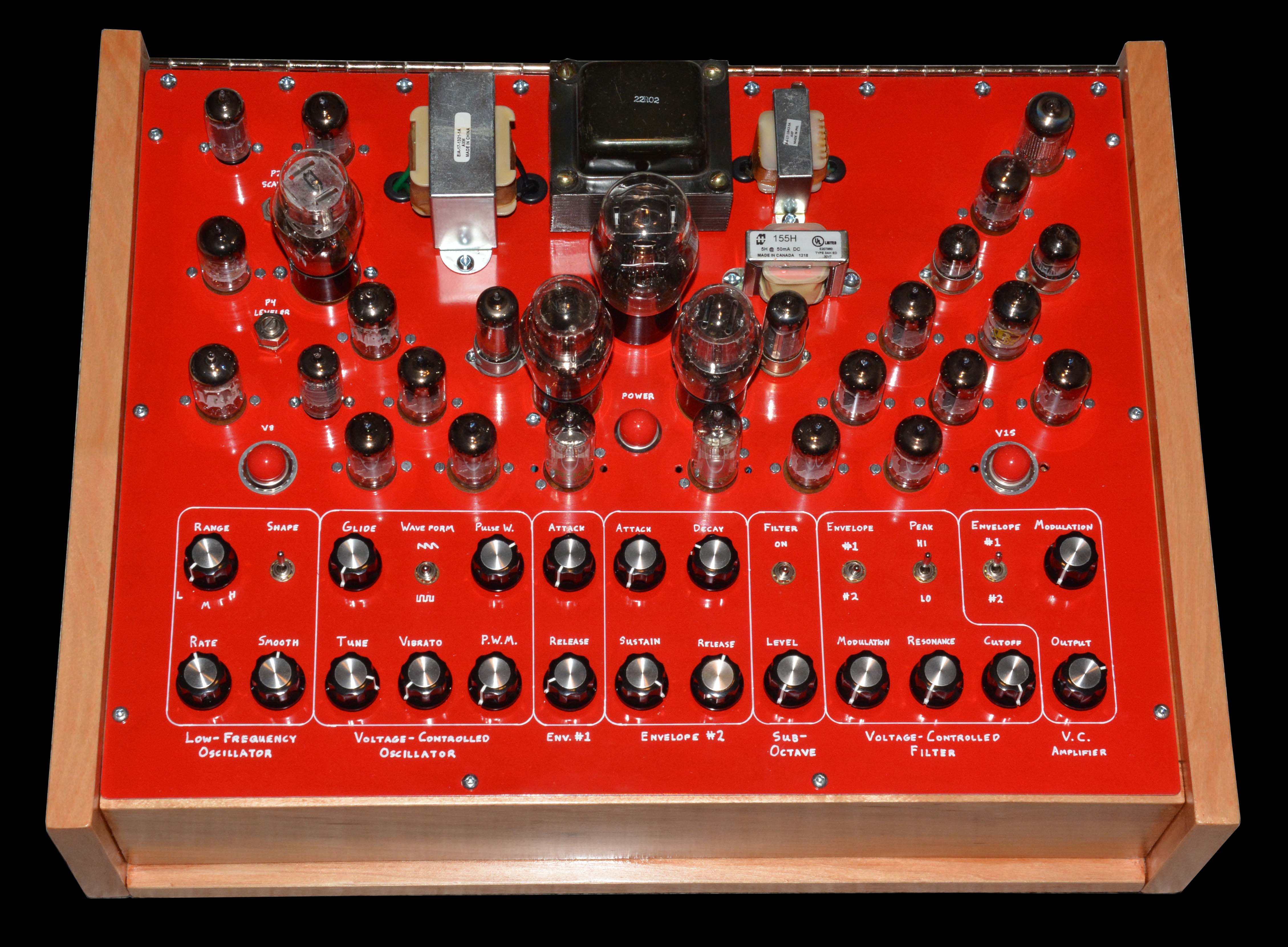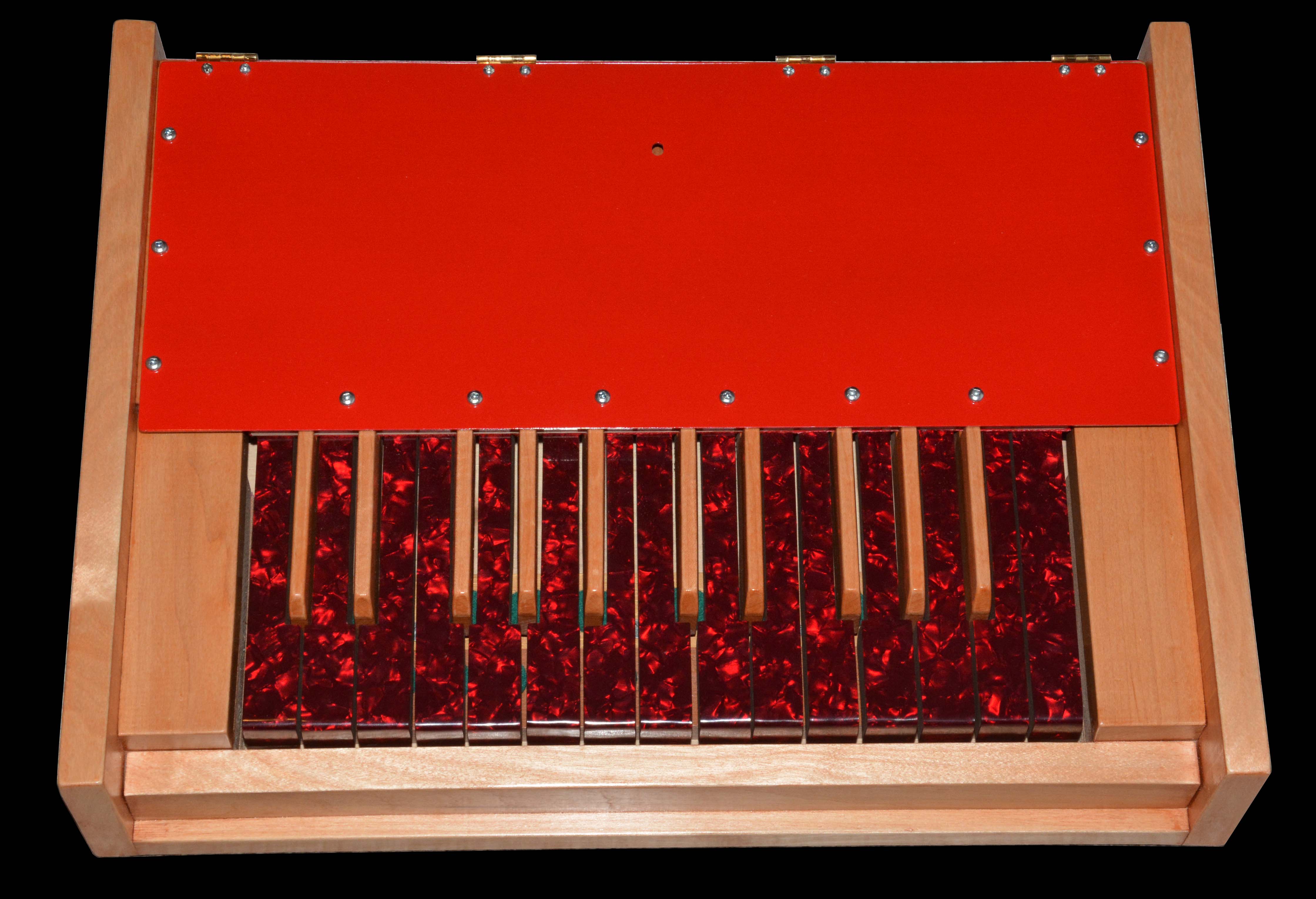Products of Crasno At the moment, all Crasno products are made-to-order. To give examples of what I have made, below are three working prototypes of my designs that I once considered selling as regular products. From left to right, there is a novel kind of tremolo effect that can "swing", a stereo hi-fi tube amplifier utilizing large Soviet triodes, and a special kind of transistor organ based on the Jankó keyboard layout. 

 While these designs could be duplicated upon request, I have decided not to market them, since I don't see any real need, nor are they truly what I want to offer. My products should reflect my desires, and what I would especially like to see is a revival of complex, imaginative, and well-crafted music played on keyboard instruments—acoustic, electromechanical, and analog electronic—by talented musicians without the aid of computers. In my opinion, this type of music last peaked in popularity and development in the 1970s under the label of "progressive rock". By the 1980s, it was largely replaced by guitar-based ensembles playing much simpler and less imaginative forms (think punk rock, arena rock, and metal), and repetitive, overly simplified synth-based music (think synthpop, new wave, and hip-hop). Today, music in general has fallen into a deep trough of constant regurgitation, zero complexity, pointless vulgarity, and immense computer fakery. Part of the problem is cultural, and while I do what I can to change culture, there is only so much I can do. Another problem is that suitable keyboard instruments for playing my kind of music are rare and getting rarer. Much of my efforts, both in business and on my own time, are directed towards preserving the best electronic, electromechanical, and acoustic keyboards of the past, as well as old sound-processing and recording gear. But no matter what, the moment new production of something stops, it can only become rarer. Many of the greatest types of keyboards have not been made in over 40 years. Yet, their technologies have not been furthered and improved upon; except for acoustic pianos (and some computer-controlled, cheaply built "analog" synths), major manufacturers have abandoned all methods of tone generation except digital. Generally, modern digital keyboards deliver a wide range of cheesy, bland, and otherwise boring sounds, almost all imitative—yet, their imitations of vintage instruments are unrealistic and functionally limited, besides that thousands of old keyboards have no digital counterparts at all. Not only do digital keyboards fail as substitutes, but because they are so imitative, they are not distinct enough to have a "sound of their own" the way vintage keyboards do. Digitals also have low build quality and serviceability, as typical of modern electronics. No wonder there isn't much inspired keyboard music around anymore, and that keyboards as a class have lost prestige. Discussing these points with my customers—especially those with old keyboards of their own—many of them agree with my sentiments, and hopefully not just to be polite. It seems to me that there may be a market for musical keyboards really capable of original, beautiful, organic, and powerful sounds generated without computing. By the mid or late 2020s, I hope to begin producing some. There are two categories I want to focus on. Firstly... Electron-Tube Musical Instruments
 I specify "electron-tube" rather than just "vacuum-tube" because both vacuum and gas-filled tubes will be used. In fact, while not terribly useful in guitar or hi-fi amplifiers, gas tubes can be extremely useful in musical instruments. They can also be quite pretty; in the image above-right, the prominent orange glow is coming from within the plate structure of a neon-filled regulator tube. On the left are a pair of "magic eye" vacuum tubes: small cathode-ray devices used for level indication. Between the magic eyes is an incandescent bulb with red lens. Why use tubes? Firstly, because tube-based circuits can produce signals and impart effects that are extremely difficult (if not impossible) to replicate by solid-state or digital means. My instruments will sound considerably different from any modern keyboards—in a good way—and I do mean considerably different, not like the subtle distinctions between solid-state and tube amplifiers. Secondly, tubes are the most physically interesting and beautiful of all electronic components; they glow, they produce warmth, they are housed in smoothly curved glass envelopes with shiny inner coatings, they have intricate visible structures inside, they smell good when warm, and they are large enough to handle easily. Thirdly, tube-based electronics are the most inherently serviceable (i.e. easily repairable) of all, meaning such devices can last for generations. As well, tube-based keyboard instruments were commercially produced for only a short time: roughly 35 years, from the early 1930s to the mid-1960s. The field still has plenty of unexplored areas, not to mention existing concepts that never saw commercial application. Even the commercial instruments—mostly organs—that were made still haven't been used to their full potential. You may ask: "aren't tubes terribly unreliable?" Not really. While average operating life varies by type and manufacturer, typical figures are between 1,500 and 30,000 hours for a given tube. Life is especially long when tubes are operated well within their ratings (as will be true), and used in circuits that will function even with weak or slightly defective tubes (as many of my circuits will). Granted, transistor and IC-based circuits are usually more reliable, but also less serviceable—especially modern digital IC-based designs. Also, tubes practically do not age while sitting around—they are hermetically sealed and contain "getters" to trap gas particles, and thus air cannot contaminate nor react with the internal elements. Many tubes from the 1920s and 30s still work perfectly. Unrelated to the inherent properties of tubes, I believe there are four main causes of the overstated unreliability of tube devices:
When tubes do eventually fail—as all things will—replacement is as easy as can be: just pull out the old one, and pop in a new one. Their socketed nature also makes troubleshooting simple, since tubes of the same type can be swapped to see if the problem follows the tube. My instruments will be made as reliable and serviceable as possible, to the point where they can last indefinitely with occasional maintenance. They will use only plastic-film capacitors, which have near-perfect reliability and extremely stable properties. No electrolytics will be used, since film capacitors of high capacity and small size are now available. Fixed resistors will be film and wirewound types, which are also extremely stable and reliable. There will be no circuit boards; all wiring will be point-to-point, which in comparison is both easier to service and more reliable. A bare minimum of plastics will be used; wood and metal will be the main materials. By wood, I mean real solid wood, and possibly veneered plywood at worst—no MDF, particleboard, or other types of glued-together sawdust. No semiconductor devices will be used, meaning there will be no MIDI. You will have to actually play the instrument. Speaking of which, my keyboard mechanisms will either be wooden and similar to acoustic pianos (a style known to last more than 100 years with little maintenance), or primarily metal and similar to early electronic organs (e.g. from Hammond, Conn, etc.). I have also created a very reliable and long-lasting keyswitch design using magnetically-operated reed switches. These are hermetically sealed, and thus have extremely long contact life: a rated minimum of 2,000,000 cycles... when operated 1.25 times above their rated maxima! And if one ever fails, reed switches are cheap, plentiful, and standardized. A detailed manual—including instructions, service info, and schematics—will be included with each instrument. So, what about their capabilities: their sounds, controls, etc.? I don't want to give too much away just yet, but here are some general ideas that may apply to my first model:
For now, suffice it to say they won't sound quite like anything else in existence, and that a good variety of satisfying tone colors and variations in expression will be possible. I have already finished one prototype electron-tube instrument, which is a monophonic synthesizer intended for playing basslines. The pictures above and below show this device. It has one sawtooth VCO with a pulse converter and squarewave frequency divider, a wide-range LFO for vibrato and pulse-width modulation, one each of AR and ADSR envelope generators (with magic eye indication), a lowpass VCF, and a VCA, all implemented without any semiconductors. If it has a flaw, it is that the thyratron-based VCO is relatively unstable. This is not a problem for me, but I would like my commercial instruments to be better—and they will be, since I will use much more stable designs controlled by component values rather than voltages. The keyboard and main unit are separate, but this is not necessary, and in fact my next instruments will probably be self-contained. 

Electrostatic PianosElectric (or, more precisely, electromechanical) pianos are among the greatest keyboard instruments, having been used on countless well-loved recordings. Digital imitations are inadequate, besides being less inherently interesting and long-lasting. While some real electric pianos are still being made, specifically Vintage Vibe's Rhodes-style tine pianos using electromagnetic pickups, there are currently no models using electrostatic pickups in production, and haven't been for more than 40 years. Yet, these are my favorites, since their sounds are more harmonically rich than Rhodes-type pianos. Famous members of this class are the various Wurlitzers and Hohner Pianets (excluding models T and M). Of the two, I especially like the Pianets, the electronics and mechanics of which are so elegant that low-volume production of similar instruments seems practical. My intention is to make an instrument similar to the electrostatic Pianets, yet higher in build quality and perhaps more versatile in sound. In terms of build, there are multiple areas of potential improvement. For one, Hohner used veneered particle-board even on early Pianets, which is cheap and flimsy. They also used urethane foam pads that decompose quickly. My instruments would not use either. There are also several ways to increase versatility. It has been known since the very first electrostatic instruments that harmonic content varies greatly depending on the shape and location of pickups relative to the tone generating elements, typically reeds. Multiple pickups per reed could be installed, and the method of pickup adjustment could be improved. The success of this project mainly depends on finding a reliable source of high-quality steel reeds. Hohner, being an accordion maker, seems to have used very similar reeds in Pianets as in their accordions, so I will keep that in mind... Prices of all products are undetermined. The instruments will not be cheap, but they will be well-built and satisfying to play. I welcome any comments. |